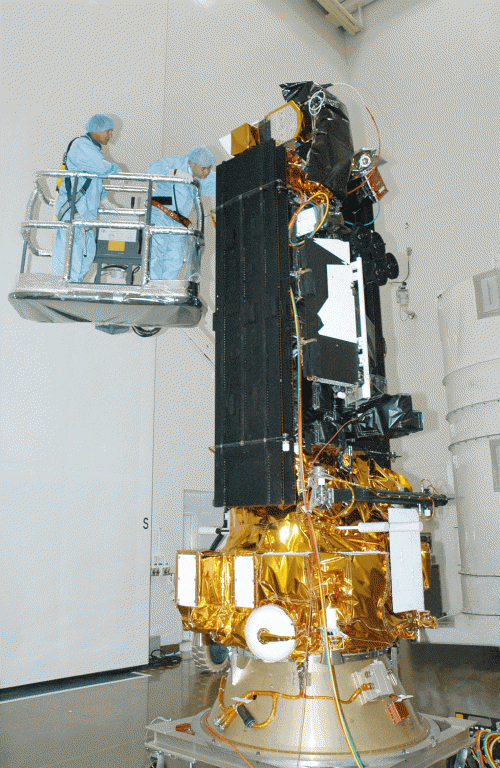
The U.S. Strategic Command’s Joint Space Operations Center (JSpOC) at Vandenberg AFB, Calif., is monitoring a cloud of new space debris in polar orbit to notify operational satellite controllers about potential collision hazards for critical military and civilian spacecraft and the manned International Space Station (ISS) which could cross paths with the new debris.
The potentially dangerous debris was caused by the the Feb. 3 explosion of the 19-year-old, $500 million USAF Defense Meteorological Satellite Program DMSP-13 weather satellite, built by General Electric’s Astro Space Div. and later acquired by Lockheed Martin.
“JSpOC personnel will continue to assess this event to learn more about what happened and what it will mean for users within this orbit,” said USAF Col. John Giles, JSpOC Director.
The satellite was orbiting near Antarctica when a joint team of ground controllers with the Air Force and National Oceanic and Atmospheric Administration in Suitland, Md., noted a sudden temperature spike in the satellite’s electrical subsystem, followed by an unrecoverable loss of attitude control.

The JSpOC at Vandenberg then quickly identified a debris field near the satellite, indicating that it had broken into at least 46 pieces. The Center continues to track the debris and will provide conjunction warnings if required, the Air Force said.
Six DMSPs remain operational. The satellites are used to cue imaging reconnaissance spacecraft operators to cloud-free areas and to provide units like SEAL teams with critical weather information, even for small landing zones.
Along with NOAA polar orbiters, the DMSPs also provide extremely detailed data on hurricane intensity and ground tracks. The 12-foot-long (3.7-m) spacecraft weighs 1,832 lb. (831 kg).
The Air Force declined to reveal the breakup until amateur trackers discovered the debris cloud. Russell Eberst in Scotland, one of the most experienced trackers, discovered the failure Feb. 9. Eberst is affiliated with the SeeSat-L tracking group. The observation of 46 pieces of debris through March 8 indicates the explosion was small, imparting only 0.1 meter per sec. velocity to the parts, said Canadian Ted Molczan who coordinates SeeSat-L data.
According to the Air Force, DMSP 13 was the oldest continuously operational satellite in the 52-year history of the weather constellation.
In 2014, the vehicle eclipsed 100,000 orbits while it provided continuous optical and infrared weather imagery to globally distributed users. Launched in March 1995, DMSP Flight 13 reached nearly 20 years of operational service.
“Due to an earlier loss of recording capability mission data and the launch of more modern DMSP satellites, Flight 13 transitioned from a primary mission satellite to a residual satellite in 2006,” said the Air Force.
The Air Force said that “DMSP Flight 13 provided critical atmospheric data for flight operations in OPERATION ALLIED FORCE, OPERATION ENDURING FREEDOM and OPERATION IRAQI FREEDOM. During its lifetime, DMSP Flight 13 also provided thousands of hours of weather imagery to the Air Force Weather Agency and the U.S. Navy’s Fleet Numerical Meteorology and Oceanography Center.”
This is the second aging DMSP to explode in orbit. In April 2004 the 13-year-old fully retired DMSP-11 broke into 56 pieces of debris. Investigators believe that breakup was caused by a battery explosion, also a potential factor in the DMSP-13 incident. Both satellites had far exceeded their four-year design lives.
Want to keep up-to-date with all things space? Be sure to “Like” AmericaSpace on Facebook and follow us on Twitter: @AmericaSpace





Excellent article, Craig. One wonders about other aging satellites that may pose a threat to ISS and future manned missions beyond Earth orbit.
Human crewed Von Braun wheels in GEO and shielded with water acquired from lunar ice deposits are the solution to the present decaying satellite junkyard. The SLS modified with wet workshops and carrying semi-expendable robot landers to ferry up lunar water derived from ice deposits is the key.